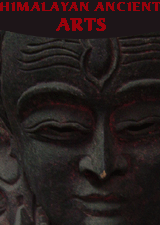Shop
By Type |
 |
|
|
|
|
|
|
|
|
|
|
|
|
|
|
|
|
|
|
|
|
|
|
|
|
|
|
|
|
|
|
|
|
|
|
|
|
|
|
|
|
|
|
|
|
|
|
|
|
|
|
|
|
|
|
|
|
|
|
|
|
 |
 |
Travel Packages  |
 |
 |
Newsletter |
 |
|
|
 |
|
 |
|
 |
|
 |
|
 |
|
 |
|
 |
|
 |
|
|
|
|
| MEANING OF BUDDHA IMAGES |
|
Meaning of Buddha images
In keeping with their emphasis on the oldest and most fundamental teachings, Theravada Buddhists produce only a narrow range of Buddhist imagery. Nearly every Southeast Asian Buddha image is made in one of these postures (mudras) that can easily be identified by the position of the hands:
- Dispelling Fear: Hand raised with palm facing outwards and fingers extended in a universal gesture of protection, benevolence, and peace.
- Teaching: Hand raised with palm facing outwards and index finger forming a circle with the thumb.
- Teaching the First Sermon: Both hands together at the chest with fingers on one hand forming a circle representing the “wheel of law” while the other hand touches the wheel to set it in motion (representing the beginning of Buddhist teaching)
- Meditation: Hands resting together on the lap. The gesture symbolizes perfect balance of thought and tranquility.
|
|
- Calling the Earth to Witness: With palm inwards, the right hand touches the ground and “calls the earth to witness” the Buddha’s enlightenment. The gesture symbolizes unshakable faith and resolution and is the most common posture for Southeast Asian temple images.
- Passage to Nirvana: The reclining Buddha representing the Buddha’s death. The posture symbolizes complete peace and detachment from the world.
- Offering or Wish Granting: Hand points down with palm facing out. The gesture represents the offering of Buddhist teaching to the world. Sometimes the teaching, and its benefit, is symbolically represented by a small piece of medicinal myroloban fruit. One particularly majestic style of standing offering image with the robes flared out is also known in Thailand and Laos as the “Calling for Rain” posture.
Each of these positions can be associated with a moment in the Buddha’s life that has an important lesson, although the description of these scenes varies considerably. For example, Burmese temple murals of the moment of the Buddha’s enlightenment depict the seated Buddha being challenged by an army of demons summoned by the devil, Mara. The Buddha’s hand touches the ground to summon the Earth Goddess who wrings out her hair to unleash a flood that sweeps away the demons. A substantially different version of the story has Mara verbally challenging the Buddha: “Who knows that you have attained enlightenment?” The Buddha touches the ground and calmly replies: “Mother Earth knows.” Seated images are normally based on a lotus leaf, a symbol of spontaneous (i.e. divine) birth. An example of traditional art showing scenes from the Buddha's life is here.
|
 |
|
| |
 |
| |
| |
|
|
|
|
|
| |
 |
|
 |
| |
|
|
| |
| |
|
|
 My
Shopping Basket My
Shopping Basket |
 |
| |
 Best
Seller Best
Seller |
 |
 |
 |
|
Grape Pashmina Shawl |
| Price: US$
71.43 |
|
|
|
| |
 Start
with your budget Start
with your budget |
 |
|
|
| |
 Tell
a friend Tell
a friend |
 |
Tell a friend and win exciting gifts...
Click here
to learn more. |
 |
 |
 |
 |
 |
 |
 |
| |
 |
|